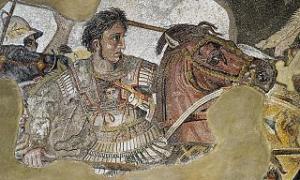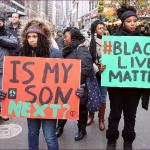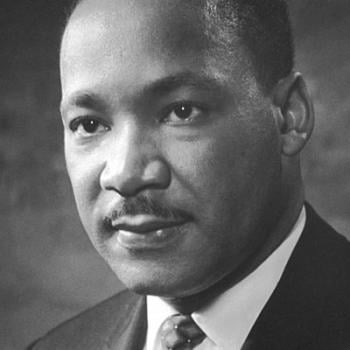
Last Monday, police withdrew from six blocks of Seattle’s “Capitol Hill” neighborhood, abandoning the area to protesters. The protesters established a “Capitol Hill Autonomous Zone,” or “CHAZ.” Yesterday, Tucker Carlson announced sarcastically, “The world welcomes its newest country,” mocking the “zone” as an attempt to establish an independent nation. Carlson’s intro made his attitude to the broader phenomenon of “Black Lives Matter” protests clear. “Vandals are defacing our country,” he declared. And it’s clear that for him, the founders of the “Zone” are among the “vandals.”
Not only that, but they are, according to Carlson, “conquistadors.” They have simply seized territory and claimed it by force. They are attempting to run the community on anarchist lines, but that won’t work. “Anarchy never lasts. The strong dominate the weak. . . . It took barely a day for CHAZ to get its first warlord.”
King Raz of Chaz
This “warlord,” described by Carlson as a “monarch,” is a rapper named Raz Simone. In an interview with Ari Hoffman of the Canadian conservative periodical The Post Millennial, Simone comes across as reasonable and even tentative. He repeatedly says that he can’t give definitive answers about the zone’s plans because he can’t speak for everyone. He explains that the protesters are staying out of the abandoned police precinct building in order to avoid “falling into a trap of a narrative of thugs running into the building and ransacking or something like that.” He doesn’t sound remotely like a “monarch” or a “warlord.” That didn’t stop The Post Millennial from entitling its article “interview with the so-called warlord of Seattle’s autonomous Zone.”
So why is Simone a “warlord”? He’s posed for pictures toting weapons, but as far as I can tell he’s not the only armed person in the “Zone.” He apparently has a “crew” who follow him around and also carry weapons. But multiple reports also describe a group called the “John Brown Club” present with weapons providing security. The zone appears to be making decisions through a “town hall” process and I haven’t heard any evidence indicating that Simone dominates this. He appears to be one fairly prominent participant who has weapons and has taken some “policing” responsibilities on himself.
On two occasions, film footage shows him getting into altercations that involved violence. During the protests, he confronted “citizen journalist” Omari Salisbury, apparently accusing him of “causing dissension” or possibly being an undercover operative. On the video, he lunges at Salisbury and apparently knocks him to the ground, ending the footage. (By the way, anyone wanting coverage of the Seattle situation should follow Salisbury on social media. This link will alert you when he begins live coverage on Facebook.) On Sunday, June 7, Salisbury and Simone posted a video together declaring that they had reconciled.
The Battle of the Graffiti
On Tuesday night, the second night of the existence of the Zone, Simone confronted a graffiti artist who was spray painting a message over an existing mural on a wall apparently belonging to a private owner. The full video of the altercation is nearly an hour long, though much of it is only audio. (The woman taking the video, who appears to be an associate of Simone’s, put it in her pocket but left it on.) Initially, Simone approaches the painter, whose name appears later to be Stephen, and asks him courteously not to deface the wall. He (or possibly one of his associates) explains that the owners are “being nice to us” and allowing the protesters “to stay here.” “We are the police of this community now,” he declares. “We are the leaders of the community.”
Stephen ignores him. Just before the 2-minute mark, Simone approaches Stephen and puts an arm over his shoulder. Stephen tells him to get off him and apparently pushes him away. There’s a scuffle. The woman holding the phone claims she didn’t assault Stephen but she “could have” and defends giving him a “love tap.” She tries to get Stephen and his friends to walk away and shouts “let him leave.” She then engages in a long conversation with either Stephen or one of his friends, attempting to explain why vandalism is no longer OK and that there are plenty of places where he can express his creativity.
At about 12 minutes into the video (with the phone now in the woman’s pocket), there’s a second, more serious confrontation, in which somebody breaks Stephen’s glasses and takes his phone. Simone orders him to sit on the ground and forces him to have a conversation about why what he was doing was wrong. Stephen understandably protests that they’ve attacked him and broken his glasses. Eventually this gets through to Simone and his friends and they offer to replace his glasses. Stephen continues to protest that in the meantime he can’t see.
And so it goes on, with altercation interspersed with long periods of calmer dialogue and many protestations about the need to have an “open discussion” and solve problems peacefully. Stephen keeps getting upset, and they keep trying to calm him down, but they don’t seem to want him to leave. Eventually everyone seems to reconcile, and Simone later posted that he and Stephen were now getting alone fine and that Stephen’s father wants him to mentor Stephen.
The dubious fall of the monarch who never was
This video constitutes the primary evidence for Simone as “warlord.” And more broadly, many commentators on social media have used it to prove that the CHAZ is rapidly devolving from anarchy to tyranny. President Trump tweeted on Wednesday that “terrorists” had taken over Seattle and military action was necessary. Simone apparently thought this was an attack on him and complained that Trump had “put a hit on his head.”
On Thursday, The Post Millennial published its interview with Simone, using the “warlord” moniker. That same day, old tweets of Simone’s surfaced using anti-gay slurs. Various people on social media gloated that this would be the end of Simone, and scoffed that it took homophobia to get the leftists to turn on their “warlord.” One Twitter user asked who would be in charge now that Raz had fallen?
But as far as I can see, Simone was never in charge. He’s continued to tweet, denying being a warlord, mocking the idea that he’s a “monarch,” and urging people not to listen to FOX News’ misrepresentations. (Meanwhile, on Friday, FOX broadcast images purportedly from the Zone that turned out to be digitally altered.)
We are the police–who are we?
While the altercation with “Stephen” certainly demonstrates, for the second time, Simone’s capacity for violence, it’s clear that he and those with him did seek some kind of reconciliation and sought to make restitution for the damage to Stephen’s glasses. It’s also clear that they were, rightly, deeply concerned about reining in the more lawless members of the protest movement as they made the transition to occupying territory. At one point someone, possibly Simone, admits that he was “into” the property destruction earlier. But now, he explains, we need to build something positive and make the area as beautiful as possible, to show we can take care of ourselves without the police.
The frequent offers of hugs and reconciliation may be their own form of coercion. But they testify, I think, to the sincere ideals of Simone and his companions. They are trying desperately to do something very difficult. They are trying to maintain order and the respect of the residents who have accepted their occupation, without becoming as brutal as the police they have replaced. They clearly have some work to do in that regard, and Simone may not be the best person to do it. But that’s not really my call. And I find many of the responses to the video unreasonably cynical.
In particular, many people have taken the phrase “we are the police now” to be a claim of raw power. But I don’t think that’s what it means. Given the context of the entire video and the tone and emphasis of the statement, I think it means, “we the protesters as a whole” rather than just “I and my gang of armed vigilantes.” The point is not, I think, “we can do whatever we want,” but rather “we the protesters are now responsible to find our own ways of keeping order.”
The enemy we need
Why does all this matter? Why have I engaged in this perhaps excessively detailed work of “microhistory” of a relatively minor event from the past week?
Trump’s tweet provides the answer. President Trump is openly calling for a military response to the CHAZ. He, and his right-wing followers, are mocking the governor of Washington and the mayor of Seattle for not recognizing the acute danger posed by these “communists” in their midst.
The “coronation” of Raz Simone as a warlord on very slender evidence reinforces a narrative in which the CHAZ is a dangerous, violent attack on America. And we know how Americans respond when they accept that kind of narrative. They respond with massive, lethal violence, both outside and inside their own borders.
We’ve seen this before
When I was eleven years old, in 1985, the Philadelphia police attacked a compound in Philadelphia inhabited by an “anarcho-primitivist” African-American community, “MOVE.” The bombs they used ignited a fire in which eleven people died, including five children. I remember how other kids talked about this at the time. They spoke not of the tragedy of the bombing but of how disgusting it was that the MOVE members “ate garbage.” And God help me, I didn’t really take in the horror of what had happened either. Dehumanizing descriptions of the victims made their deaths seem something other than an atrocity.
When I was eighteen years old, in 1993, the Bureau of Alcohol, Tobacco, and Firearms raided the Branch Davidian compound in Waco led by David Koresh, in order to investigate charges of sexual abuse and illegal firearms possession. Koresh and his followers violently resisted the initial raid, with deaths on both sides. The ATF, and then the FBI, laid siege to the compound. In the final assault, a fire erupted killing seventy-six people, including 25 children. This is a more complex case, because Koresh was clearly a violent and abusive figure and probably was responsible for the fire (and the bullet wounds found on many survivors). But a bit more patience might well have prevented the deaths.
Now I am forty-six years old. I have lived through years of the American and British government waging war in the Middle East supposedly to protect me and people like me from terrorists. I’ll be damned if by word or silence I cooperate in any way with a violent response to the CHAZ or to other manifestations of the BLM protests.
The warlord within
St. Augustine tells the story of the pirate who confronted Alexander the Great with the fact that what Alexander did was simply a large-scale version of piracy. A government without justice, Augustine warns us, is nothing more than a large band of robbers.
If the Trump administration authorizes a violent attack on the protesters currently occupying the Capitol Hill district of Seattle, then the Trump administration, not Raz Simone, is the warlord.
The task of governing a community without giving in to what Augustine calls the libido dominandi, the lust for dominating others, is extremely difficult. Mr. Simone, and others in the CHAZ, may well have succumbed to that lust. It has stricken down many. It is the Ring of which Tolkien wrote. It draws us all.
But in depicting the “autonomous zone” as nothing more than a chaotic barbarism ruled by a “warlord,” conservative media are telling us more about themselves than about the little would-be utopia in Seattle. And insofar as that narrative is plausible to us, they are telling us something about themselves as well.
We see warlords everywhere, because we all have a warlord within us. And the constant practice of European “white” people–the very thing the BLM movement is protesting–is to project the image of our inner warlord onto a dark-skinned “other” and then use that projection as an excuse to unleash the warlord of our own sinful hearts upon the world. Tucker Carlson labeling the protesters “conquistadors” is only a particularly grotesque and recent example.
I say again: we will all be damned, as a society, if we consent to this. We know too much. God has sent us sign after sign, warning after warning, culminating in the tumultuous events of the last few weeks.
We are Nineveh. And only the repentance of Nineveh will save us from the wrath that is coming.












